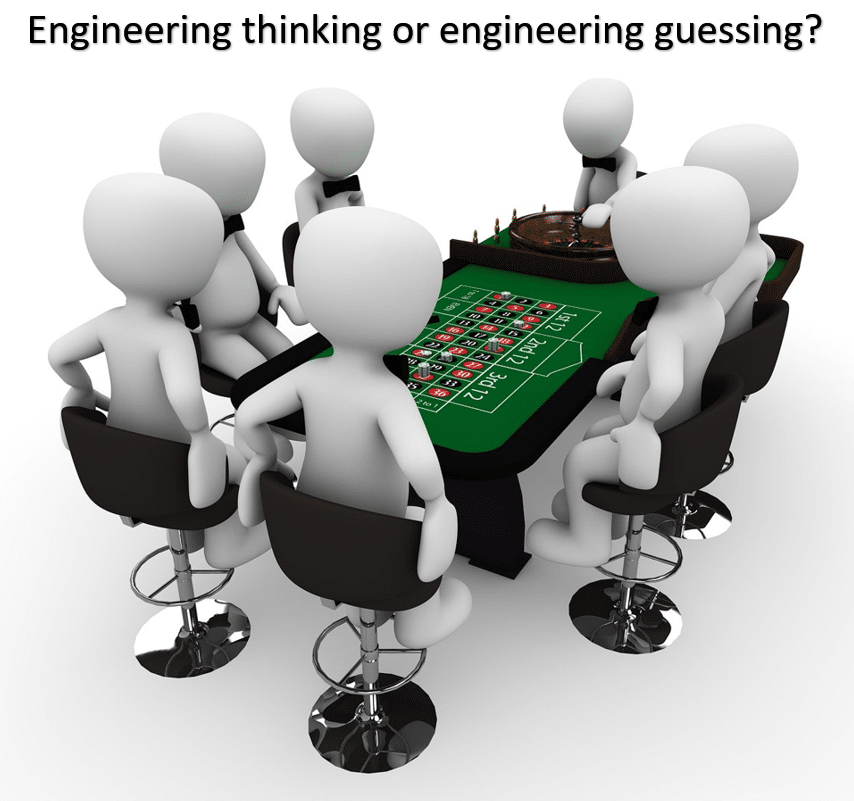This article discusses the importance of using the engineering method of problem solving in an engineering environment instead of resorting to engineering guessing. It covers the dangers of engineering guessing and the benefits of using this structured method. The article also outlines a systematic approach to problem-solving using problem-solving tools and facilitation, such as the PRIZ Innovation platform. Proper documentation, defining the problem statement, identifying root causes, and understanding the process are all essential components of the engineering method of problem solving, which is the only way to generate fast and effective solutions.

A healthy and growing production can lead to two types of problems: expected and unexpected. We covered the origin and types of problems in our article “Where do problems come from?”.
Known or expected problems are chronic issues such as low yield, high cost, or insufficient production equipment availability.
Unknown or unexpected problems are related to sporadic failures in product or process parameters. In some plants, this is called an “excursion.” This can include a significant drop in yield, variations in electrical parameters, an increase in defect count, and more.
Regardless of the type of problem, a systematic approach is required to analyze the issue and generate fast and effective engineering solutions.
To address a problem, managers often form a “task force” – a team of the best engineers to analyze and tackle the issue.
The engineers gather in a conference room with computers and coffee to begin solving the problem. The task force owner (typically the manager) outlines the details of the challenge and requests potential solutions. Unfortunately, engineers often jump straight into throwing out ideas, skipping the necessary analysis. They usually start with engineering guessing, a popular thinking tool used at the beginning of the problem-solving process. Engineers often refer to this step as “Brainstorming,” but it is actually just guessing and does not constitute a proper brainstorming session.
Why do engineers resort to guessing? Because it is easy, like in a casino. There is no need to think, but there is a chance to win. It is an easy and fast solution. According to the Cambridge Dictionary, guessing is to give an answer to a particular question when you do not have all the facts and so cannot be certain if you are correct. This is an excellent general definition.
Another source – “The Content Authority,” provides a more relevant definition to our case: “Guessing is a passive process that does not involve active mental effort or logical reasoning. It is often based on incomplete or inaccurate information and can lead to incorrect conclusions or decisions.”
Even engineering guessing cannot result in a reasonable solution to a problem.
Unfortunately, in many cases, the first step remains the only step in solving the problem. Engineers continue guessing, wasting time and money. This is the worst-case scenario for a company.
Engineers may find a temporary solution that allows them to continue manufacturing, but this typically results in additional expenses and prevents company development.
Managers and engineers should stop so-called “brainstorming” and replace guessing with a systematic problem-solving process. They typically start with 5 Whys to perform a Root Cause Analysis and may seek assistance from professional facilitators.
Skip the engineering guessing step and apply engineering thinking from the beginning, using problem-solving tools and approaches.
Engineering thinking is an intellectual activity that involves creatively solving problems using scientific principles. We have already defined this concept in our article, “The Art of Engineering Thinking with the PRIZ Platform”.

To engage in engineering thinking, problem-solving tools, and facilitation are required. The facilitator can be either a person or a platform (a machine).
Professional problem-solving is based on engineering thinking and avoids any guesswork.
We offer the PRIZ Innovation platform as a facilitator for problem-solving.
Document all the information relevant to the issue. This includes sketches, images, links, and articles. Avoid making conclusions about the possible reasons for the issue or potential solutions. Focus solely on gathering factual data.
It is important not to confuse a problem with a failure. A failure is an issue that is observed and generates several problems. The main difference is that a problem can be analyzed and solved, while a failure cannot be fixed. We discussed this in detail in our article “How to Define a Problem Statement.”
Engineers cannot improve yield, reduce production costs, or remove defects from an affected product because all such issues are not problems; they are failures, indicating that problems exist. However, engineers can investigate issues, improve process parameters, replace costly materials, train staff, and take other actions to solve production process problems. PRIZ Platform offers an AI facilitator for professional problem definition to help us with defining the correct problem statement.
Root Cause Analysis (RCA) is a frequently used approach that many managers are familiar with and request engineers to use. RCA is typically performed by utilizing the Cause and Effect Chain Analysis (CEC) and 5 Whys creative thinking tools. CEC is an excellent instrument for learning how the system operates and defining the directions for the continuation of the investigation. Likewise, 5 Whys is a powerful tool for Root Cause search and generating solutions. It is important to remember that the Root Cause is the source of solving the problem, not the source of the creation of the problem.
Engineering thinking involves viewing everything as a system. A skilled engineer can develop and assess a functional model of the system to identify the most effective and which is the most problematic components that require attention. Our article covers the System Functional Modeling approach, which can be found here: “Functional Modeling with PRIZ Innovation Platform.” Functional Modeling is a valuable tool for comprehending the system and determining which components require attention to resolve issues and enhance the system.
Engineering thinking requires an engineer to have full control over the production process. This involves a deep understanding of the process. The key point is that “process understanding” is not a one-time achievement. It is an ongoing process that requires continuous improvement and refinement. Process Functional Modeling (PFM) is a professional tool used to understand the process and develop strategies to improve, eliminate, or avoid certain operations. It is important to note that while some operations create value, others may increase costs without adding value. Our article, “Unlock the Power of Process Functional Model: Identify Opportunities and Implement Solutions for Business Success,” explains the essence of PFM and provides ways to continuously improve processes.

In conclusion, engineers face various problems in a production environment, and they must approach them systematically to generate fast and effective solutions. Engineering thinking is the only way to solve problems, and it involves creatively solving problems using scientific principles. Guessing will lead to incorrect conclusions or decisions, and it is crucial to follow a problem-solving process. Proper documentation, defining the problem statement, identifying root causes, and understanding the process are all essential components of engineering thinking. The PRIZ Innovation platform is an excellent facilitator for professional problem-solving.
Do not waste time on engineering guessing; use engineering thinking.